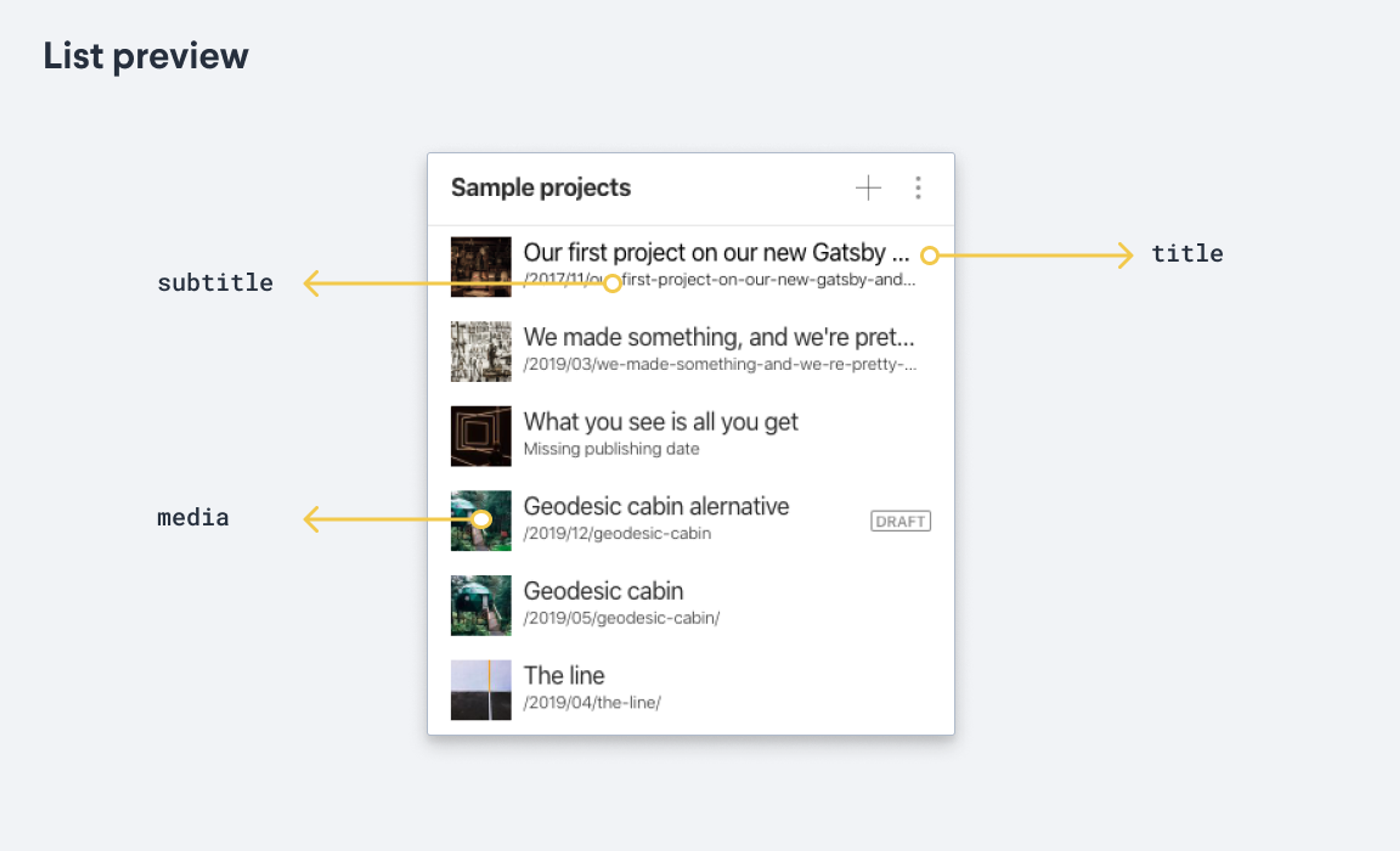List Previews
Configure and customize how documents are displayed within Sanity Studio's document lists.
Sanity Studio will often need to render a compact representation of a document or object for list views and similar situations, and we call this a list preview. You can decide which fields should be used and how by configuring the preview property on schema types. By default, Sanity Studio tries to guess which fields should be used for preview by introspecting the type's defined fields. For example, if your type has a field of type string named title, it will infer that this should be used as the title when previewing values of this type.
Sanity Studio offers two ways of customizing how documents and objects are previewed:
- Specify preview options for the type in the schema for lists and arrays to use automatically
- Implement a custom preview component to display when used as block content in the Portable Text Editor
Protip
Looking to create previews inside of the document pane? Read more on creating custom content previews inside split panes with the Structure Builder API.
For previews of content presentation in front ends, go to the documentation for Visual Editing and Presentation.
Configuring preview options
Normally, a list preview has three "slots": title, subtitle, and media. If you want to specify which fields should be used for what, you can control this by adding a preview key to the type defined in the schema. For example:
export default {
name: 'movie',
type: 'document',
fields: [
{
title: 'Title',
name: 'title',
type: 'string'
},
{
title: 'Release Date',
name: 'releaseDate',
type: 'date'
}
],
preview: {
select: {
title: 'title',
subtitle: 'releaseDate'
}
}
}Above, the preview.select object will inform the Sanity Studio preview logic that for this document, movie.title should be used as title and movie.releaseDate should be used as subtitle.
This might be sufficient in many cases, but sometimes, you want to reformat the selected values. With the prepare function, you can access the values that you have selected and customize them.
Say we only want the year for releaseDate (e.g., 2016-04-25):
export default {
name: 'movie',
type: 'document',
fields: [
{
title: 'Title',
name: 'title',
type: 'string'
},
{
title: 'Release Date',
name: 'releaseDate',
type: 'datetime'
}
],
preview: {
select: {
title: 'title',
date: 'releaseDate'
},
prepare(selection) {
const {title, date} = selection
return {
title: title,
subtitle: new Date(date).getFullYear() // YYYY-MM-DD --> YYYY
}
}
}
}Above, title and releaseDate are selected. The result of this selection is passed to the prepare function, where you can transform the selection however you like (only keeping the year, in this case).
Protip
In these examples we have put the preview object after the fields array, however you can also place it before it. This might give you a better idea at first glance of how the document is previewed.
Preview using fields from referenced documents
You can follow references by using dot notation to the related document field you want to display in preview.select. Note that using GROQ joins is not supported here (it’s what the Studio will do under the hood).
Here's an example of a preview for a movie document where the director field is a reference, and the referenced document has a name field:
export const movie = {
name: 'movie',
type: 'document',
fields: [
//...other fields
{
name: 'director',
type: 'reference',
to: [{ type: 'person' }]
}
],
preview: {
select: {
title: 'title',
director: 'director.name' // if the movie has a director, follow the reference and get the name
},
prepare(selection) {
const {title, director} = selection
return {
title: title,
subtitle: `Directed by: ${director ? director : 'unknown'}`
}
}
}
}Previewing from predefined string lists
When using a predefined list of strings, you can use objects with title and value keys. This might be useful if you're using a list of U.S. states, for example: The title can be the spelled-out state, while the value can be a two-letter state code:
{
title: 'U.S. State',
name: 'state',
type: 'string',
options: {
list: [
{ "title": "Alabama", "value": "AL"},
{ "title": "Alaska", "value": "AK"},
{ "title": "Arizona", "value": "AZ"},
// ...
],
layout: 'dropdown'
}
}If you wish to use that value in your preview, Sanity will default to providing the title—unless you use a prepare() function. In that case, the value (and only the value) will be passed along to prepare().
If you want to render the title in your document preview but need to manipulate it in some way (which is done using prepare(), as seen in the second example above), you can specify your list outside of the schema, use it as your list in options.list, and then consult that list in your prepare() function. This is best explained via an example:
const STATES = [
{ "title": "Alabama", "value": "AL"},
{ "title": "Alaska", "value": "AK"},
{ "title": "Arizona", "value": "AZ"},
// ...
]
export default {
// ...
fields: [
// ...
{
name: "state",
title: "U.S. State",
type: "string",
options: {
list: STATES,
layout: "dropdown",
},
}
],
preview: {
select: {
state: 'state',
},
prepare: ({ state }) => {
const stateName = state && STATES.flatMap(option => option.value === state ? [option.title] : [])
return {
title: state ? `${state} is ${stateName}` : 'No state selected',
}
}
}
}Previewing from array values
Fetching entire arrays of values can potentially result in large and complex responses, especially in the case of large arrays. We encourage you only to select a subset of the array values:
export default {
name: 'book',
type: 'document',
fields: [...],
preview: {
select: {
title: 'title',
author0: 'authors.0.name', // <- authors.0 is a reference to author, and the preview component will automatically resolve the reference and return the name
author1: 'authors.1.name',
author2: 'authors.2.name',
author3: 'authors.3.name'
},
prepare: ({title, author0, author1, author2, author3}) => {
const authors = [author0, author1, author2].filter(Boolean)
const subtitle = authors.length > 0 ? `by ${authors.join(', ')}` : ''
const hasMoreAuthors = Boolean(author3)
return {
title,
subtitle: hasMoreAuthors ? `${subtitle}…` : subtitle
}
}
}
}Gotcha
Resolving references in arrays works the same as covered above, with dot notation.
Selecting an image field to use for the thumbnail
The easiest way to show an image in the preview is to assign a field containing an image to the media property. The different views take care of a proper rendering of the image, including any hotspot and crop specifics.
export default {
name: 'person',
type: 'document',
fields: [...],
preview: {
select: {
title: 'name',
media: 'userPortrait' // Use the userPortait image field as thumbnail
}
}
}Rendering React components
You can also use JSX to render a thumbnail. Here's an example of how to show specific emojis based on the status of our document. This example is partly taken from our Community Studio.
// src/schemaTypes/ticket.jsx
export const ticket = {
name: 'ticket',
type: 'document',
fields: [...],
preview: {
select: {
title: 'title',
summary: 'summary',
status: 'status'
},
prepare({ title, summary, status }) {
const EMOJIS = {
open: '🎫',
resolved: '✅',
cancelled: '🚫'
}
return {
title: title,
subtitle: summary,
media: <span style={{fontSize: '1.5rem'}}>{status ? EMOJIS[status] : '🎫'}</span>
}
}
}
}Custom preview component
If you want complete control of how the document or object list preview is rendered, you can also provide a React component invoked when the document or object is previewed in that context.
Gotcha
Custom preview components will only display in lists that appear inside the document pane—not in the top-level Structure tool document list.
To learn more about this option, visit the article on form components.
Preview in the Studio
Depending on how your schema is set up, here is an example of how Preview could look in your Studio. This uses title, subtitle, and media.

Form preview title

Since v3.24.1, Sanity Studio has also rendered a large title in the document form to make it easier to discern which document you are currently in. It shares the logic with list previews, looking for a preview configuration and returning to the inferred preview title. In cases you don't wish to have this title, you can turn it off:
// src/schemaTypes/location.ts
export const location = {
name: 'location',
title: 'Location',
type: 'document',
__experimental_formPreviewTitle: false,
fields: [
//..fields
],
}Was this page helpful?